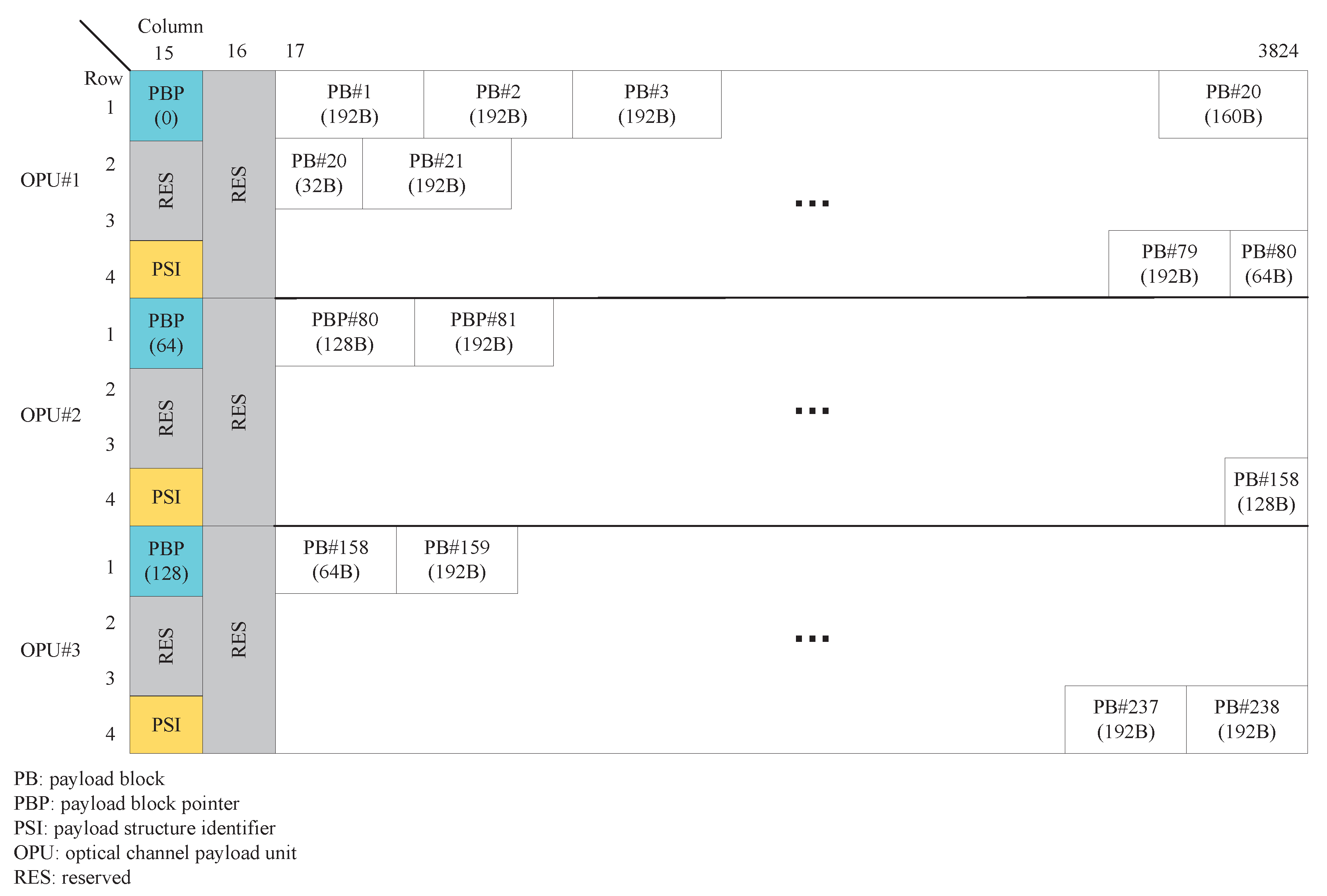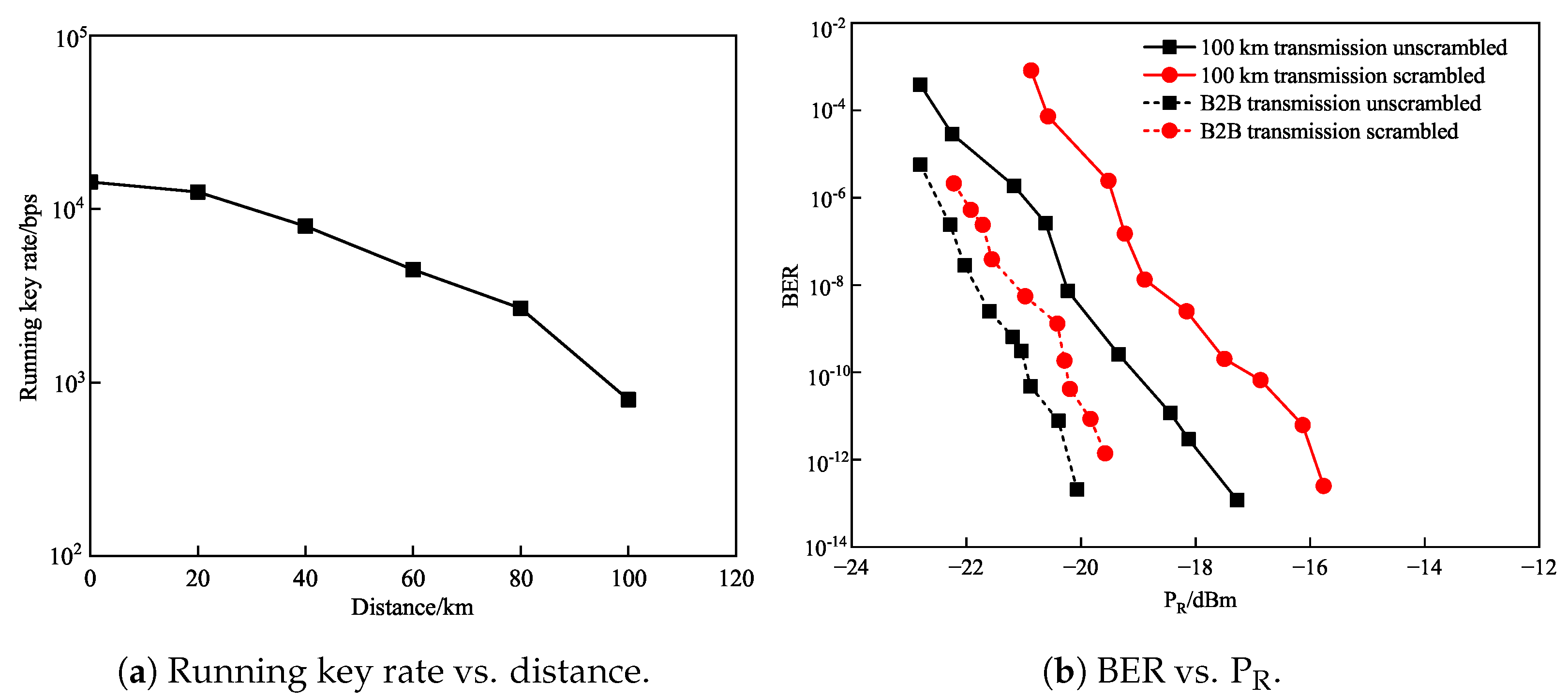Research on Key Technologies of Quantum-Safe Metro-Optimized Optical Transport Networks
Abstract
1. Introduction
2. Methods
2.1. OSU Service Mapping/Multiplexing
2.2. Time-Domain Scrambling/Descrambling Combined with DS-QKD
- Temporal rearrangement of optical pulses, creating new waveform configurations;
- Controlled inter-symbol interference through adjacent-bit overlap.
- Non-linear cross-interaction between overlapping bits;
- Noise-equivalent signal degradation from timing jitter;
- Irreversible scrambling transformations.
3. Results
4. Conclusions
Author Contributions
Funding
Institutional Review Board Statement
Informed Consent Statement
Data Availability Statement
Acknowledgments
Conflicts of Interest
Abbreviations
| DCF | Dispersion compensating fiber |
| DS-QKD | Decoy-state quantum key distribution |
| EDFA | Erbium-doped fiber amplifier |
| FBG | Fiber Bragg Grating |
| FPC | Fabry–Perot cavity |
| FPGA | Field-programmable gate array |
| Och | Optical channel |
| ODU | Optical channel data unit |
| OMS | Optical multiplex section |
| OPS | Optical packet switching |
| OPU | Optical channel payload unit |
| OSTU | Optical service branch unit |
| OSU | Optical service unit |
| OTS | Optical transmission section |
| OTU | Optical channel transport unit |
| PB | Payload block |
| PBP | Payload block pointer |
| PSI | Payload structure identifier |
| SMF | Single-mode fiber |
| TCM | Temperature-controlled module |
| WDM | Wavelength-division multiplexer |
References
- Lo, H.K.; Curty, M.; Tamaki, K. Secure quantum key distribution. Nat. Photonics 2014, 8, 595–604. [Google Scholar] [CrossRef]
- Gulati, J.; Raman, R. Quantum Key Distribution: Harnessing the Power of BB84 for Secure Communications in the Post-Quantum Era. In Proceedings of the 2024 International Conference on Trends in Quantum Computing and Emerging Business Technologies, Pune, India, 22–23 March 2024; pp. 1–6. [Google Scholar]
- Anantraj, I.; Umarani, B.; Karpagavalli, C.; Usharani, C.; Lakshmi, S.J. Quantum Computing’s Double-Edged Sword Unravelling the Vulnerabilities in Quantum Key Distribution for Enhanced Network Security. In Proceedings of the 2023 International Conference on Next Generation Electronics (NEleX), Vellore, India, 14–16 December 2023; pp. 1–5. [Google Scholar]
- Jing, R.; Zhang, C.; Zhou, H.; Li, J.; Qiuyou, W.; Zhang, Y.; Wang, Y.; Su, W.; Gong, Y.; Huo, X. Innovation and demonstration of optical service unit-based metro-optimized OTN technologies. J. Opt. Commun. Netw. 2022, 14, 236–247. [Google Scholar] [CrossRef]
- Chao, F.; Jing, R. Research on the Network Architecture and Service Model of Government and Enterprise OTN Network Based on OSU Technology. Study Opt. Commun. 2024, 1–10. Available online: http://kns.cnki.net/kcms/detail/42.1266.TN.20241011.1111.004.html (accessed on 10 February 2025).
- Zhou, W.; Luo, Q.; Xie, X.; Jing, C.; Cheng, X.; Pan, B. Communication-computing-integrated satellite routing optimization algorithm based on OISL-OSU. Opt. Commun. Technol. 2024, 48, 51–59. [Google Scholar]
- Skorin-Kapov, N.; Furdek, M.; Zsigmond, S.; Wosinska, L. Physical-layer security in evolving optical networks. IEEE Commun. Mag. 2016, 54, 110–117. [Google Scholar] [CrossRef]
- Dahan, D.; Mahlab, U. Security threats and protection procedures for optical networks. IET Optoelectron. 2017, 11, 186–200. [Google Scholar] [CrossRef]
- Uematsu, T.; Hirota, H.; Kawano, T.; Kiyokura, T.; Manabe, T. Design of a temporary optical coupler using fiber bending for traffic monitoring. IEEE Photonics J. 2017, 9, 7106013. [Google Scholar] [CrossRef]
- Murtaza, G.; Colautti, M.; Hilke, M.; Lombardi, P.; Cataliotti, F.S.; Zavatta, A.; Bacco, D.; Toninelli, C. Efficient room-temperature molecular single-photon sources for quantum key distribution. Opt. Express 2023, 31, 9437–9447. [Google Scholar] [CrossRef] [PubMed]
- Zhao, Y.B.; Gui, Y.Z.; Chen, J.J.; Han, Z.F.; Guo, G.C. Computational complexity of continuous variable quantum key distribution. IEEE Trans. Inf. Theory 2008, 54, 2803–2807. [Google Scholar] [CrossRef]
- Qi, R.; Sun, Z.; Lin, Z.; Niu, P.; Hao, W.; Song, L.; Huang, Q.; Gao, J.; Yin, L.; Long, G.L. Implementation and security analysis of practical quantum secure direct communication. Light Sci. Appl. 2019, 8, 22. [Google Scholar] [CrossRef] [PubMed]
- Thomas, J.M.; Yeh, F.I.; Chen, J.H.; Mambretti, J.J.; Kohlert, S.J.; Kanter, G.S.; Kumar, P. Quantum teleportation coexisting with classical communications in optical fiber. Optica 2024, 11, 1700–1707. [Google Scholar] [CrossRef]
- Lopez-Bastida, A.; Mercado-Zúñiga, C.; Bornacelli, J.; de la Rosa, J.M.; Torres-Torres, C. All-Optical Encryption Controlled by Multiphotonic Absorption in Carbon Nanotubes. Photonics 2024, 11, 1029. [Google Scholar] [CrossRef]
- Garcia, C.R.; Cano, A.; Olmos, J.V.; Rommel, S.; Monroy, I.T. Integrating Quantum Key Distribution into TLS 1.3: A Transport Layer Approach to Quantum-Resistant Communications in Optical Networks. In Proceedings of the Optical Fiber Communication Conference, San Diego, CA, USA, 24–28 March 2024; p. Th3B–3. [Google Scholar]
- ITU-T Study Group. Optical Service Unit (OSU) for Next-Generation Transport Networks; Draft Standard G.osu (Draft); International Telecommunication Union: Geneva, Switzerland, 2023; Work in Progress (Expected publication Q3 2024). [Google Scholar]
- ITU-T, Interfaces for the Optical Transport Network (OTN), Recommendation G.709, International Telecommunication Union, June 2022. Available online: https://www.itu.int/rec/T-REC-G.709 (accessed on 10 February 2025).
- Tian, C.; Zhang, Z.; Ibsen, M.; Petropoulos, P.; Richardson, D.J. A 16-channel reconfigurable OCDMA/DWDM system using continuous phase-shift SSFBGs. IEEE J. Sel. Top. Quantum Electron. 2007, 13, 1480–1486. [Google Scholar] [CrossRef]









| Ethernet Service Rate | C Value | 1 (Kbps) | 2 (Kbps) |
|---|---|---|---|
| 10 Mbps | 4 | 10,400 | 10,020.833 |
| 100 Mbps | 40 | 104,000 | 100,208.333 |
| 1 Gbps | 400 | 1,040,000 | 1,002,083.333 |
| 10 Gbps | 3996 | 10,381,800 | 10,003,296.875 |
| OPU Type | (Kbps) | p Values | PB Actual Bit Rate (Mbps) |
|---|---|---|---|
| OPU0 | 1,238,954.310 | 476 | 2.602845189 |
| OPU1 | 2,488,320.000 | 956 | 2.602845188 |
| OPU2 | 9,995,276.962 | 3840 | 2.602936709 |
| OPU3 | 40,150,519.322 | 15,426 | 2.602782272 |
| OPU4 | 104,355,975.330 | 40,096 | 2.602653016 |
| Device | Manufacturer | Model |
|---|---|---|
| M-OTN | CETC, Guilin, China | Design with XILINX 7V690T |
| Scrambler/descrambler | CETC, Guilin, China | Design with XILINX 7K325T |
| DS-QKD | QuantumCTek, Hefei, China | QKD-POL1250-S |
Disclaimer/Publisher’s Note: The statements, opinions and data contained in all publications are solely those of the individual author(s) and contributor(s) and not of MDPI and/or the editor(s). MDPI and/or the editor(s) disclaim responsibility for any injury to people or property resulting from any ideas, methods, instructions or products referred to in the content. |
© 2025 by the authors. Licensee MDPI, Basel, Switzerland. This article is an open access article distributed under the terms and conditions of the Creative Commons Attribution (CC BY) license (https://creativecommons.org/licenses/by/4.0/).
Share and Cite
Zhou, W.; Guo, B.; Cao, B.; Cheng, X. Research on Key Technologies of Quantum-Safe Metro-Optimized Optical Transport Networks. Appl. Sci. 2025, 15, 2809. https://doi.org/10.3390/app15052809
Zhou W, Guo B, Cao B, Cheng X. Research on Key Technologies of Quantum-Safe Metro-Optimized Optical Transport Networks. Applied Sciences. 2025; 15(5):2809. https://doi.org/10.3390/app15052809
Chicago/Turabian StyleZhou, Wei, Bingli Guo, Boying Cao, and Xiaohui Cheng. 2025. "Research on Key Technologies of Quantum-Safe Metro-Optimized Optical Transport Networks" Applied Sciences 15, no. 5: 2809. https://doi.org/10.3390/app15052809
APA StyleZhou, W., Guo, B., Cao, B., & Cheng, X. (2025). Research on Key Technologies of Quantum-Safe Metro-Optimized Optical Transport Networks. Applied Sciences, 15(5), 2809. https://doi.org/10.3390/app15052809






